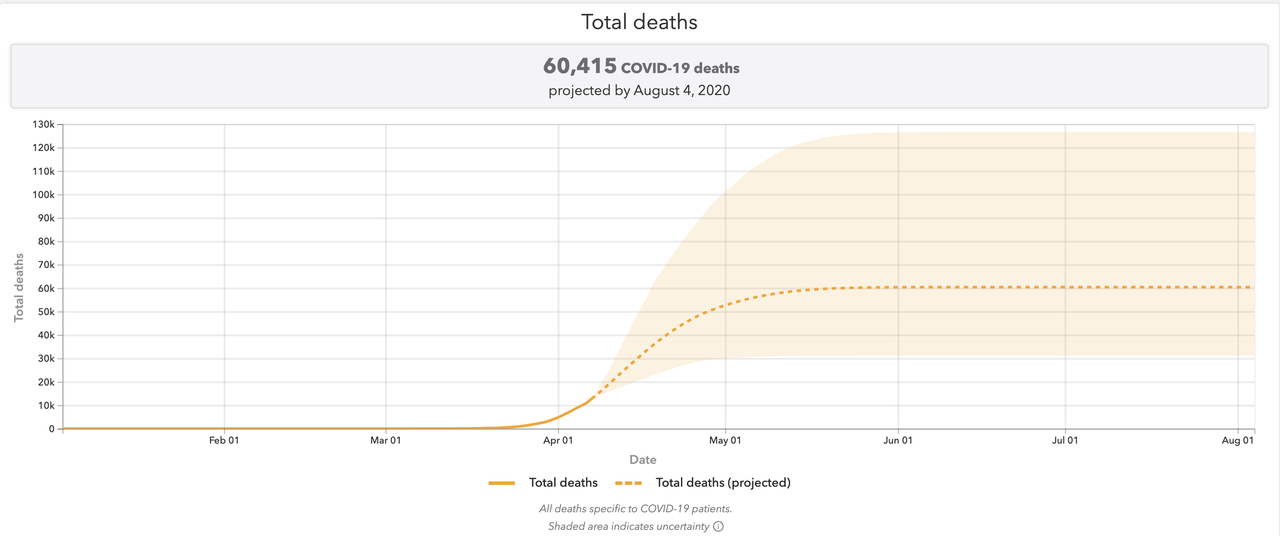New Projections Show Virus Spreading Twice As Fast As Expected
Trying to project the path and velocity of an outbreak is difficult, even when it’s being done on a relatively small scale like, say, within one country, or a handful of countries, like the last few major outbreaks (for example, ebola). Trying to project the arc of an unprecedented pandemic is educated guesswork, at best.
Projections, and the differences in their outcomes depending on the variance in inputs, have become something of an obsession for traders and politicians alike. Since the US government doesn’t produce its own projections, the most popular data cited in the US are projections produced by an institute at the University of Washington. The IMHE projections have been cited by Cuomo, de Blasio and Trump alike.
Any traders who weren’t familiar with the projections before Tuesday or Wednesday probably are now: a revision published last night produced a moderate swing downward in expected deaths across the US, to just 60,400 by August. Previously, the model projected around 90k before.
Of course, around the world, there are probably dozens of sets of projections, all produced by “credible” researchers, all saying slightly different things. And now, one of those researchers has caught the attention of Bloomberg by announcing that it may have underestimated the virus’s velocity by half, meaning it’s been spreading twice as quickly through China – and will therefore likely follow (or has followed) a similar pattern in the US.
This set of projections was produced by researchers at Los Alamos, BBG said.
As the CPC lifts travel restrictions on “healthy” residents of Wuhan – sending tens of thousands scrambling to escape the city – the team of researchers has determined that the virus likely spread through the country twice as quickly as initially believed.
New assumptions produced by the team including the average number of people infected in the early days of the epidemic in Wuhan: they have been revised to 5.7, more than twice the number the WHO has projected.
Of course, the team’s results are specific to the Chinese outbreak. But although Beijing hesitated during the early days of the outbreak, it’s heavy handed response likely won’t be mimicked by the West, meaning if the virus spread more quickly in China, it’s reasonable to expect that it could travel through the US at around the same speed.
At any rate, with this new rate of spread, researchers determined that some 82% of the population would need to be immune, either via a vaccine or because they’d already had the disease, in order to stop the virus from spreading. Without such protection, high levels of social distancing would be needed, since as many as 1/5 people infected present as asymptomatic, a factor that has terribly complicated the response to the virus.
While some parts of China begin instating restrictions over fears of the second wave (which we’ve noted is likely coming now that Beijing has unleashed a flood of Wuhan residents on the country), Germany and Austria are trying to figure out how to start reopening the economy, as is the White House.
Notably, the Los Alamos report, which was initially published in Emerging Infectious Diseases, relied on anonymized mobile phone travel data and case reports of coronavirus outside the early epicenter in China’s Hubei province to calculate the spread, all things considered, that should be some pretty accurate data, if the authorities haven’t tampered with it. Then again, if they had, the numbers would probably look a lot better than they do.
Unless…
Tyler Durden
Wed, 04/08/2020 – 22:00
via ZeroHedge News https://ift.tt/2XprcgX Tyler Durden

